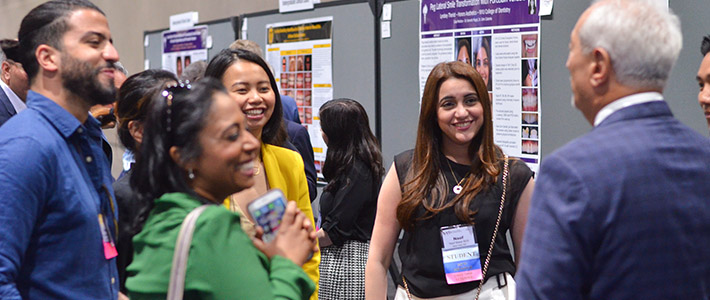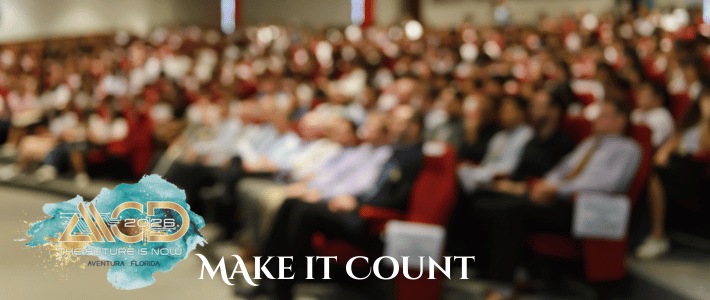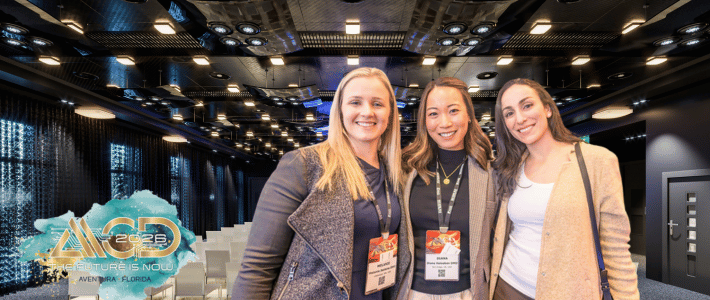As part of the AACD Annual Scientific Conference, undergraduate, postgraduate students, researchers and junior dental faculty were encouraged and invited to share their clinical cases and research with the larger cosmetic dental community through a scientific poster competition. Accepted posters were judged on-site by a panel of university faculty (unaffiliated with the credentialing arm of the Academy) and participants also shared their scientific findings and interacted with the larger dental community during a viewing reception.
In consideration that participants are beginning to explore education in cosmetic dentistry, the AACD Credentialing standards were not applied to the judgment of this poster session. The winners were announced Friday, April 26th at AACD 2019 San Diego and on Saturday, April 27th during Student Day the Poster Award Winners gave a 10-minute verbal PowerPoint presentation on their poster.
Without the dedication and passion of the dental community, the advancements of cosmetic dentistry would not be where they are today.
*Recognition in the poster session does not imply compliance with the AACD's Credentialing Standards nor does it imply the achievement of Accreditation or Accreditation-level dentistry.
Congratulations to our winners:

Undergraduate Clinical
1st Place – Matthew Yeung, Virginia Commonwealth University
Restoring the Esthetic Zone Using In-House CAD/CAM Monolithic Lithium Disilicate Crowns
The patient presented with failing restorations and esthetic needs for maxillary anterior teeth and first premolars with a desire of whiter teeth. Increased horizontal and vertical overlap of the existing restorations led to fremitus of the maxillary incisors. Guidance was improved in the diagnostic wax-ups which were used to fabricate bis-acryl provisional restorations which assessed shade, shape and function. After a three week evaluation, in-house CAD/CAM workflow was used to scan, design, and fabricate lithium disilicate crowns. The treatment successfully accomplished in three appointments using digital workflow to satisfy the patient’s chief complaint, shade and gingival recession, while improving functional occlusion.
2nd Place – There was a tie:
Lyndsey Theriot, New York University College of Dentistry
Margaret Duszyk, University of Pennsylvania
3rd Place – Oksana Nad, New York University College of Dentistry
 Undergraduate Materials Science
Undergraduate Materials Science
1st Place - Alan Meskin, New York University College of Dentistry
3D Printed Interim Crowns: A Literature Review
Recent trends in digital dentistry have moved from computer-aided manufacturing (CAM) milling systems to 3D printing of dental restorations. To date, 3D printing allows the fabrication of various dental applications, but scientific evidence is limited when compared to traditional processes. The purpose of this review is to evaluate the literature on the effect of 3D printing processing and mechanical properties on the fit and durability of interim restorations. After conducting a comprehensive electronic search via EBSCO Discovery.
 Post Graduate Clinical
Post Graduate Clinical
1st Place – Fabio Perez Rubio, New York University College of Dentistry
Clinical Management of a Large Arch Length/Tooth Size Discrepancy
The treatment of the patient described in this poster revolved around the patient’s desire to close the spaces between her anterior teeth without undergoing orthodontic treatment. The severity of each of the specific diastemata and the lack of room for the tongue were addressed. Porcelain laminate veneers were used to close the spaces, producing a result that was satisfying from both aesthetic and functional perspectives.
2nd Place – Juliana Gil Andrade, New York University College of Dentistry
3rd Place – Shun Chien, Tufts University School of Dental Medicine
 Post Graduate Materials Science
Post Graduate Materials Science
1st Place - Shelyn A. Yamakami, Harvard School of Dental Medicine
Effect of Desensitizing Treatments in the Evolution of Erosive Lesions in Dentin
Dentin hypersensitivity causes daily discomfort to patients affecting their esthetics and habits. This study evaluated the desensitizing agents in the evolution of the erosive lesions(EL) on dentin. It is hypothesized that there is no difference among treatments in the EL progression. Dentin specimens were immersed in 6% citric acid and randomly divided into 6 groups(n=15): G1=no treatment; G2=oxagel(Kota,Brazil); G3=nano-hydroxyapatite(FGM,Brazil); G4=MI PasteTM(GC Corporation,Japan); G5=experimental-paste; G6=970nm-diode laser0.7W/10Hz/70mJ(Sirolaser,Germany). Thereafter, they were cycled through erosive challenge(0.3%citric acid/9-days) and treatments were applied every 3- days. Samples were evaluated by confocal laser scanning microscopy/permeability test. Data were compared by ANOVA, Friedman and Tukey’s Test(α=5%). Nanohydroxyapatite was able to control the EL in dentin and experimental-paste was effective on dentin tubule occlusion/permeability.
 Junior Faculty Clinical
Junior Faculty Clinical
1st Place – Dhanny Medianti, New York University College of Dental Medicine
Multidisciplinary Treatment of Short Tooth Syndrome
This poster presents the treatment of a patient who came to our clinic with a chief complaint of short teeth. The process of coming to a diagnosis and arriving at a treatment plan for this patient is presented. Ultimately it was determined that the patient suffered from short tooth syndrome as a consequence of a lack of passive eruption. This poster will review the techniques required to come to a diagnosis and to formulate a treatment plan that will result in a predictable esthetic outcome. The multidisciplinary approach used in this case is presented.
2nd Place – Bhavna Gangwal, New York University College of Dental Medicine
3rd Place – Ruth Schmuelian, New York University College of Dental Medicine
 Junior Faculty Materials Science
Junior Faculty Materials Science
1st Place – Tamer Theodory, University of New England College of Dental Medicine
The Esthetic Outcome and the Infiltration Capacity of Three Resin Composite Sealers Compared to ICON (DMG, America)
The purpose of these studies was to compare the esthetic outcome and the infiltration capacity of three resin composite sealers: Biscover LV (Bisco Dental), Optiguard (Kerr) and Permaseal (Ultradent) to ICON (DMG, America) following artificial initial caries lesion resin infiltration
On behalf of the American Academy of Cosmetic Dentistry, we would like to thank all of you for your hard work and dedication to the study of cosmetic dentistry. We’ve so enjoyed having you share your research with the attendees at our scientific session and we appreciate your participation in the Scientific Poster Program.
Click here for more information on the Poster Competition.
Contact AACD Director of Publications, Tracy Skenandore, with any questions at university@aacd.com










